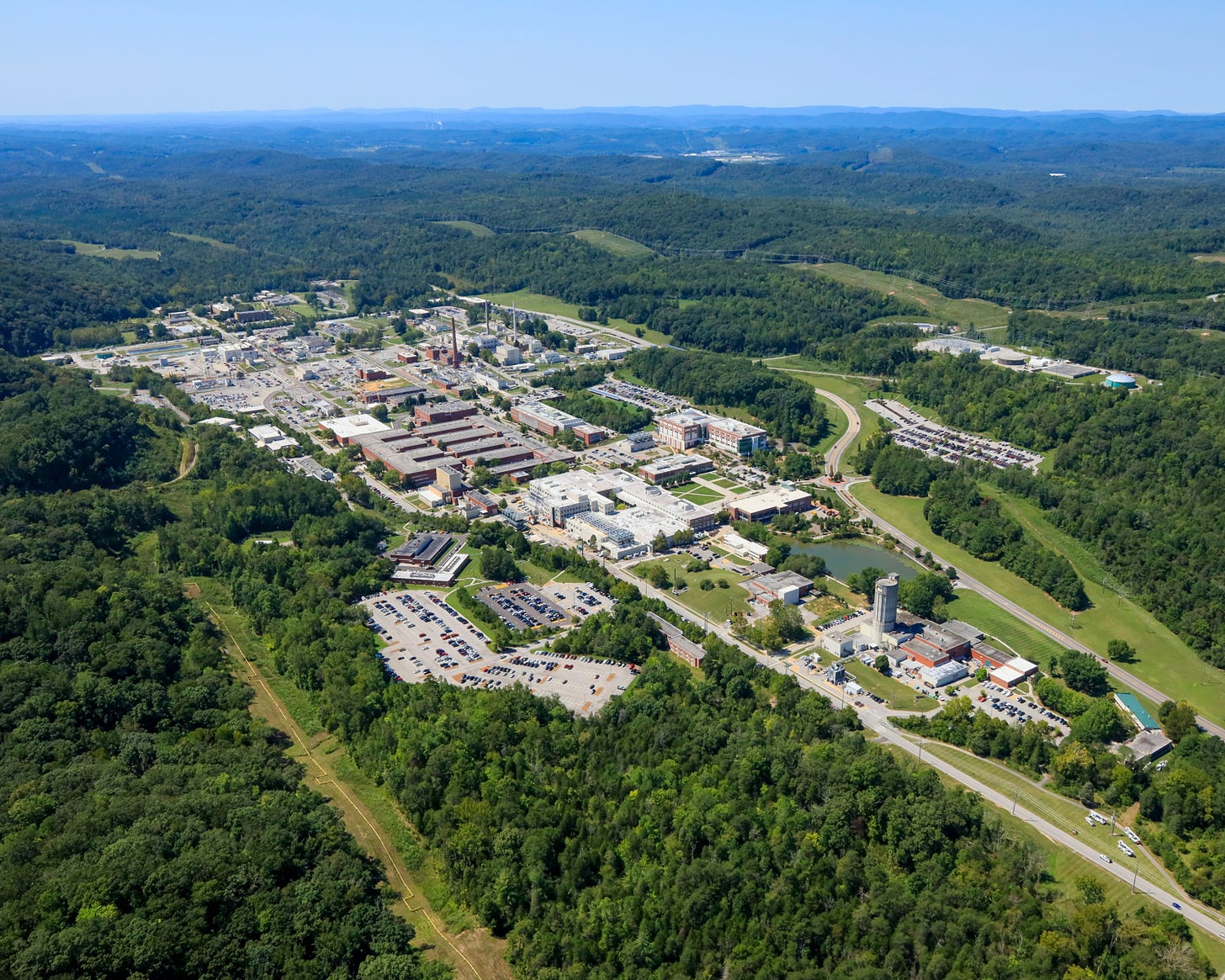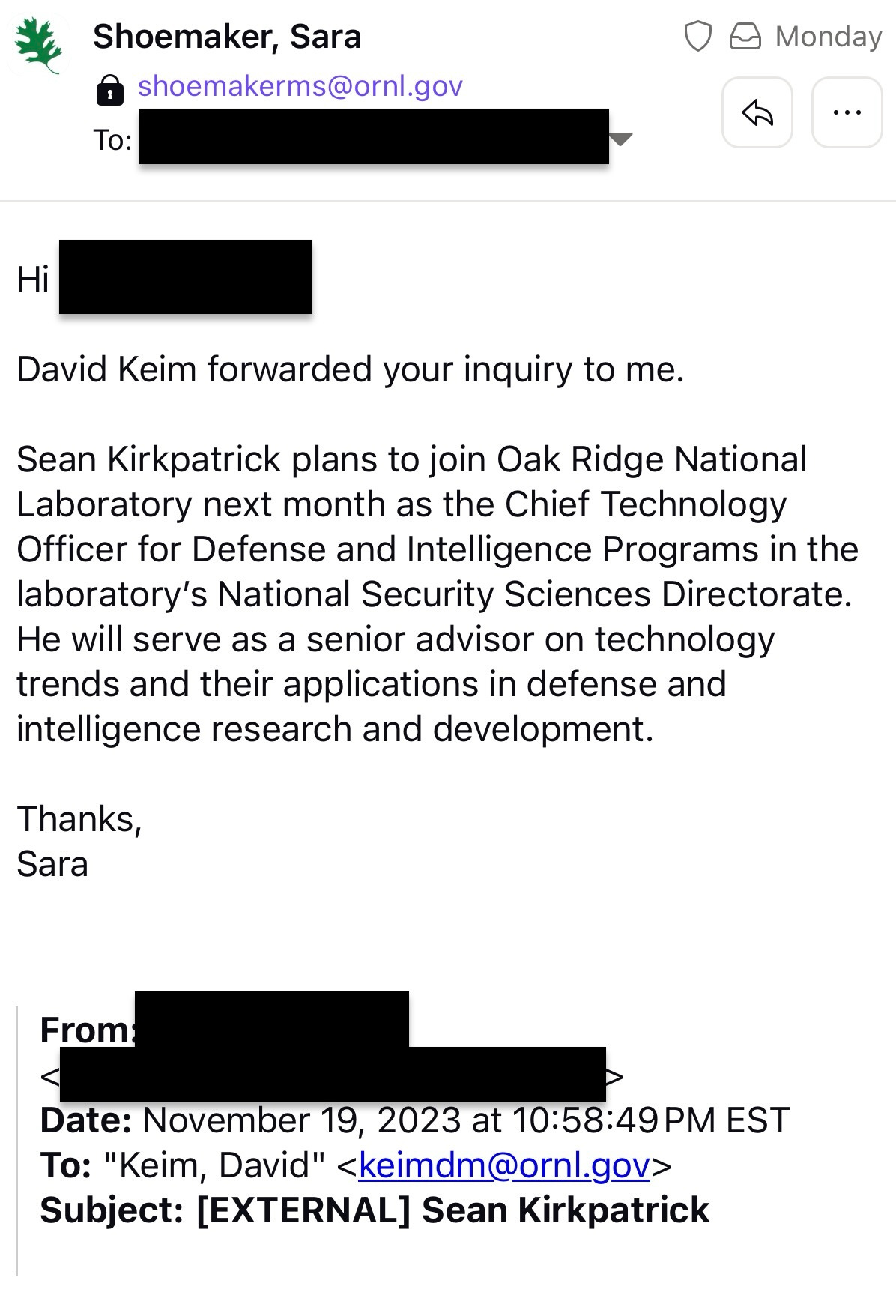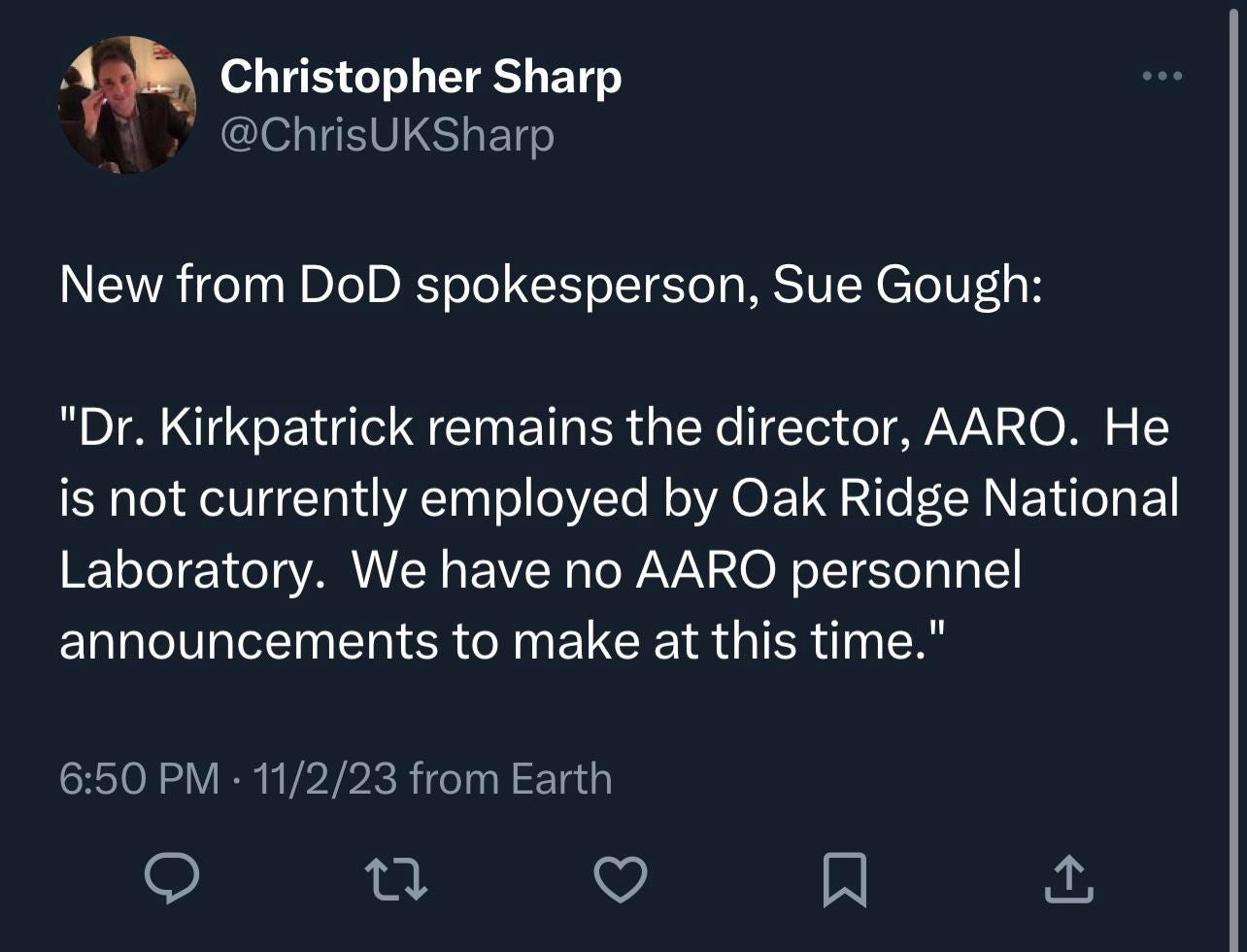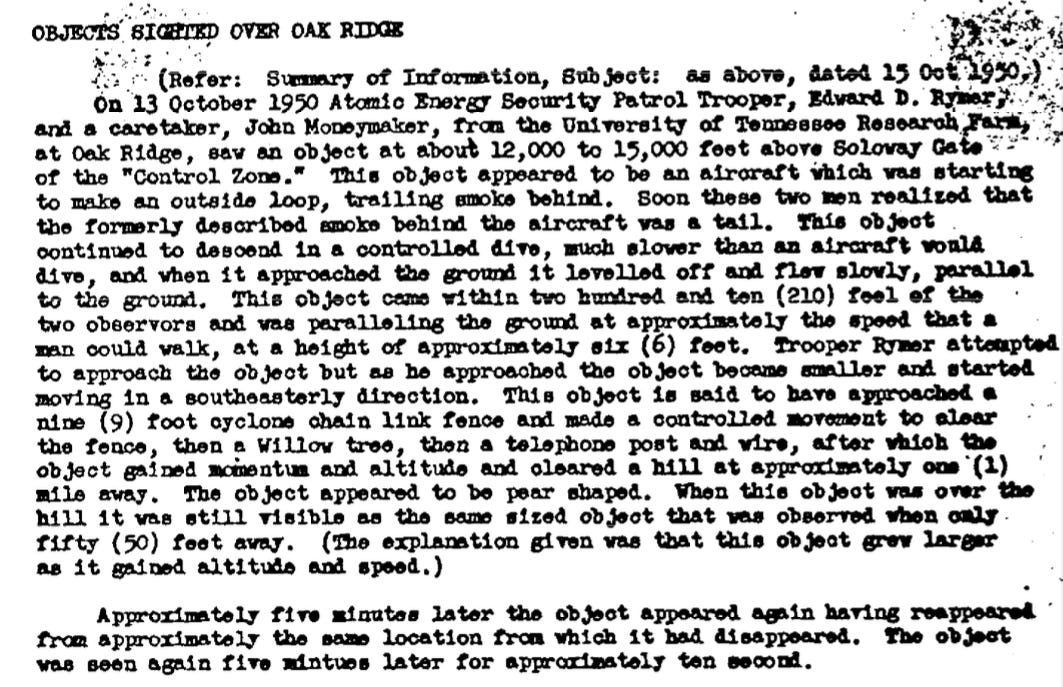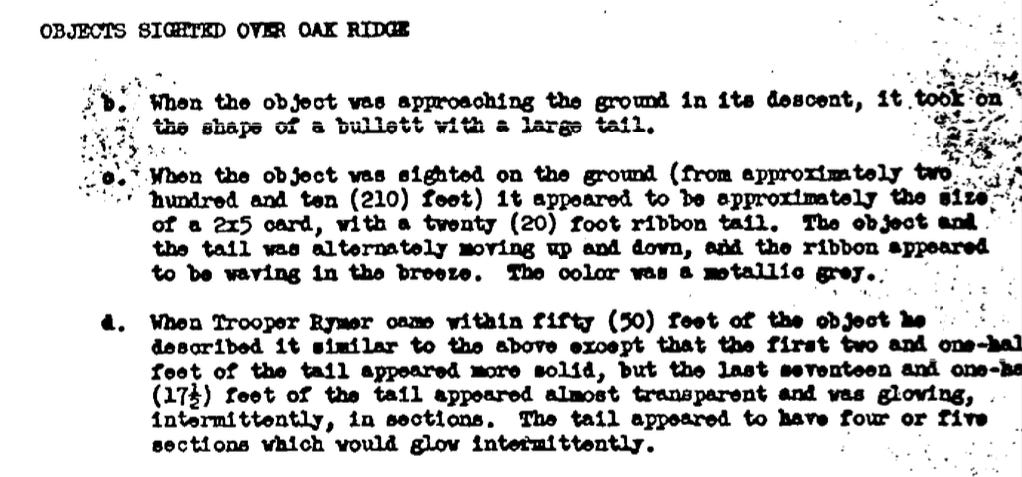Sean Kirkpatrick’s New Job Is at a UFO Hotspot Run by the Department of Energy and Battelle Institute
The Pentagon UFO chief is poetically departing his position at the All-domain Anomaly Resolution Office for Oak Ridge National Laboratory, a research facility mired in a long history of UFO sightings.
While listening to a recent episode of his podcast Need To Know, Australian journalist Ross Coulthart mentioned he was given a tip to closely examine Oak Ridge National Laboratory’s website for a hiring announcement of the now-to-be-dearly-departed Pentagon UFO chief, Sean Kirkpatrick, Ph.D. Upon hearing this news, I was intrigued and immediately scoured the internet for official confirmation of Kirkpatrick’s long-speculated move away from the All-domain Anomaly Resolution Office (AARO). A simple search of “Sean Kirkpatrick Oak Ridge National Laboratory” revealed a top Google link to his biography on the laboratory’s government website.
Sadly, public access to the link is not allowed at this time. It isn’t necessarily a surprise given Kirkpatrick’s polarizing and controversial nature in the world of unexplained aerial phenomena; his new employer likely wants to avoid unwanted attention being drawn to their new hire. Kirkpatrick hasn’t exactly followed in the footsteps of his spiritual predecessor who ran the U.S. government’s last public-facing UFO program. As a result of his alleged refusal to follow up on stunning whistleblower testimony, Kirkpatrick has been seemingly vilified by the UFO community at large. Take some time to peruse through UFO Twitter/X (or r/UFOs on Reddit) and you’ll see what I mean.
Is the criticism of Kirkpatrick justified? Well, it’s no secret that his tenure as AARO chief has been full of notable inconsistencies. Recent comments about UFOs either being technology from a foreign country or alien vehicles bear a stark contrast compared to previous remarks of his where he stated that none of the military-related sightings his office had studied could be attributed to a foreign power or non-human intelligence. The contradictory nature of his rhetoric highlights what many people have pointed out when putting Kirkpatrick’s public comments under the microscope—he’s either outright lying or wholly unsure what his stance is. Or both?
One of the most peculiar stories from Kirkpatrick’s time with AARO was his statement that whistleblower David Grusch (retired Maj.), a former intelligence official who had previously worked in the Air Force and the National Reconnaissance Office, had refused requests from AARO for interviews. Since then, Grusch has outright refuted these claims, stating, “I have zero emails or calls from them. That is a lie.”
A few days after I first took notice of the Kirkpatrick search result on Google, I decided to check again—I could not find his name anywhere about Oak Ridge National Laboratory. Again, not a surprise. So, I decided to reach out to Oak Ridge National Laboratory’s public relations team for an answer. After a day of waiting, I received an email from the laboratory’s media relations manager, Sara Shoemaker, giving me confirmation of Kirkpatrick’s hiring along with his official role and position within the federal research facility.
I thought this was odd as Kirkpatrick’s official resignation indicated he was retiring from federal service entirely. Pentagon spokesperson Susan Gough had also previously stated Kirkpatrick is not “moonlighting” for Oak Ridge National Laboratory. British journalist Christopher Sharp, editor-in-chief of Liberation Times, received the following statement from Gough at the beginning of November.
As we all know, the Pentagon is quite clever with how it crafts its press statements. Kirkpatrick is technically retiring from federal service; he is leaving AARO, a Pentagon agency, for a national laboratory that is semi-private. You have to appreciate their efforts to dance around the semantics.
Oak Ridge National Laboratory is sponsored by the Department of Energy and managed by none other than Battelle Memorial Institute, a private nonprofit company that was originally founded in 1929.
Headquartered in Columbus, Ohio, the organization has its hands in nearly everything—agribusiness, national security, materials sciences, biotechnology, and management of federally-funded research facilities like Oak Ridge National Laboratory (Battelle manages or co-manages several other federal facilities with the Department of Energy). Furthermore, Battelle is a 501(c)(3) tax-exempt organization and cannot be subjected to FOIA (Freedom of Information Act) requests. It also has clearance under the Atomic Energy Act, the law passed in 1954 which established the basis for the highest level of classified information in the United States national security apparatus. Battelle looks a hell of a lot like a government agency (and acts like one, too)—except, it doesn’t have any federal oversight.
Sounds like the perfect organization to secretly study UFOs, right? It turns out Battelle has been interested in unexplained aerial phenomena since the early stages of the Cold War.
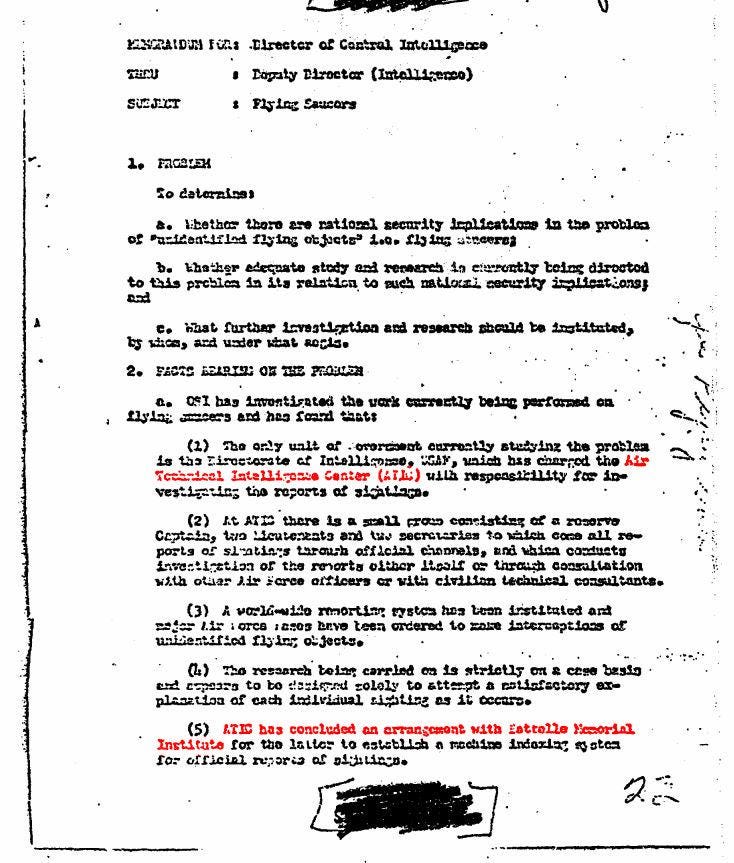
A secret 1952 CIA document acquired by The Black Vault revealed a Battelle project that was attempting to create a “machine indexing system” to catalog official reports of UFOs which sounds a lot like the original purposes of both Project Blue Book and AARO. It’s hard to imagine a Cold War-era database being the only UFO-related project Battelle has ever worked on. In fact, Jacques Vallee discussed the company’s interest in the mystery during a December 2020 episode of the Joe Rogan Experience podcast.
During the episode, Vallee discusses a famous 1952 UFO sighting that took place over Washington D.C. Vallee states the Air Force scrambled planes to intercept the radar anomalies which had also been visualized by civilians on the ground. According to him, the pilots were given authorization to shoot at the unidentified objects and did so successfully as a metallic piece from one of the objects was recovered. The metal was allegedly given to an unnamed government agency or private contractor.
Later in this part of the conversation, Rogan pushes Vallee to disclose the secretive info he knows, but the French scientist is hesitant to share his sensitive knowledge. Documentary filmmaker James Fox, who appears alongside Vallee in the episode, urges him to indirectly name the company that holds the unknown material. Vallee states he discovered a memo in J. Allen Hynek’s Project Blue Book files which was written by Battelle—the company wanted to shut down all public discussion on UFOs at the time (according to Vallee). Through this indirect confirmation, Vallee attributes the recovery of the metal to Battelle. Remember—Battelle is one of the top organizations in the country for materials sciences. There is no better candidate to disseminate materials of unknown origin to than Battelle, especially when they control almost all of the major laboratories in the United States with their FOIA-exempt status and ability to operate under the Atomic Energy Act (thus allowing them to maintain pertinent programs outside the jurisdiction of executive and state secrets).
This is the organization Sean Kirkpatrick is going to work for—as the Chief Technology Officer for Defense and Intelligence Programs in the laboratory’s National Security Sciences Directorate.
On the surface, it’s not an unusual move. Dr. Kirkpatrick has worked in a similar role before—he was assigned to the position of Chief Technology Officer for a joint CIA-DIA program in 2007 and later became a division chief in the DIA. Before his stints in the CIA and DIA, he also worked as a program manager in the National Reconnaissance Office.
Given Kirkpatrick’s history in the CIA, I wonder if he personally knows Doug Wolfe, the man who set up the CIA’s Office of Global Access in 2003 which was recently outed as the alleged unit which manages the government’s crash retrieval program of UFOs.
Wouldn’t that be an interesting connection?
If we take a closer look at Kirkpatrick’s move to Oak Ridge National Laboratory, it becomes a bit more puzzling given the site’s longstanding historical connection to the infamous Manhattan Project.
An Oppenheimer-led Los Alamos facility, tasked with designing the atomic bomb, would need enriched uranium ready for nuclear fission. So, Oak Ridge began as the result of land surveys which were conducted by the S-1 Section, also known as the Committee on Uranium. The group was started by President Franklin Roosevelt in 1939 following the previous discovery of atomic fission by the Germans at the end of 1938. S-1 advised the U.S. Army to rapidly seize the location in the summer of 1942; further plans were developed in September of that same year when the committee met at Bohemian Grove in California. A forceful U.S. government land grab would occur later that year when Col. Leslie Groves ordered the seizure of 60,000 acres. The location matched the military’s criteria not only for its rural nature but also for its proximity to Knoxville, Tennessee, and the availability of a water supply from the Clinch River for reactor cooling. The U.S. government now had its site to begin enriching uranium for the bomb.
In January 1943, the site would become known as Clinton Engineer Works and was later renamed to the Clinton National Laboratory in 1947. A year later, the official moniker of Oak Ridge National Laboratory was given to the location. Under the Department of Energy, the laboratory has been historically managed by the University of Chicago (during the war), Monsanto (1945-1948), Union Carbide Corporation (1948-1984), Martin Marietta Company and Lockheed Martin (1984-2000), and UT-Battelle (2000-present). UT-Battelle is a partnership between the University of Tennessee system and Battelle Memorial Institute.
All of Oak Ridge National Laboratory’s activities were classified until 2000 when most of the site’s projects became unclassified. After World War II, during a period of time when the laboratory’s ventures were heavily classified given its recent endeavors as a part of the Manhattan Project, high strangeness began to unfold in and around the location.
In June 1947, a Mr. W.R. Pressley photographed a strange object over Oak Ridge, Tennessee, which was cataloged by the FBI. Two years later, on June 20th, 1949, a couple witnessed three objects over the town. And then, between March 1st and March 6th, 1950, a Mr. Stuart Adcock described strange readings on his “ham” radar scope—the objects he discovered appeared at a similar time of day compared to previous sightings. Interestingly, on May 25th, 1949, a flat object described as “metallic” in nature was seen by five people around Loudon, Tennessee (a small town just south of Oak Ridge). The object was described as being accompanied by a “flapping noise.”
These events came to a head in October 1950. At 2325 hours on October 12th, 1950, the Knoxville Airport Radar Unit stumbled upon a collection of unidentified targets over the “Restricted Zone” at Oak Ridge National Laboratory. A fighter aircraft was scrambled and made interceptions of the radar hits but could not find anything at the location. By the early morning hours of October 13th, 1950, additional radar hits were seen once again, but the same fighter aircraft was not able to visualize the targets during additional passes of the location.
Two days later, Tennessee state police officers saw strange objects above one of the original secret gates to Oak Ridge utilized during World War II. Radar from the nearby McGhee-Tyson Airport would confirm these sightings; the airport also reported the acquisition of strange, unintelligible readings. The next day, similar objects were seen again by additional state police personnel. Nearby security guards would subsequently report hearing odd sounds coming from the sky. The next few days were met with additional UFO sightings by townsfolk and authorities in the area.
As I read through declassified FBI documents detailing these Cold War-era sightings in and around the vicinity of Oak Ridge, I stumbled upon longer descriptions of these encounters given by the Tennessee state police officers and Atomic Energy Security troopers who saw these objects (the October 1950 sightings mentioned above). The accounts given in these documents are lengthy, so I’ve attached screenshots from the PDF file for the sake of brevity.
These accounts given by eyewitnesses above are just a small fraction of the cases discussed in the collection of declassified FBI documents regarding sightings in and around Oak Ridge. If you are interested in reading about more anomalous cases that took place in the vicinity of the national laboratory during that time period, I highly recommend going through those documents and memos. They are truly profound and demonstrate a significant pattern of events, indicative of an underlying mystery that may be deeply connected to the history of Oak Ridge.
The laboratory’s longstanding connection to our country’s nuclear secrets may be even more noteworthy because we know there is an ocean of evidence highlighting a historical link between UFOs and nuclear weapons.
I began to ponder the implications of a large number of UFO sightings taking place above one of our country’s top national laboratories—a research facility that just so happened to be one of the original pillars of the Manhattan Project. The timing of anomalous Cold War-era sightings is particularly suspect and it raises many questions about the nature of unidentified objects appearing in restricted airspace over a facility that was conducting classified activities for our government. This thought experiment brought me to the present as it reminded me of whistleblower David Grusch’s recent comments he made for the ICER Network’s YouTube Channel regarding the origins of the UFO coverup where he stated, “the US government overlayed the Manhattan Project secrecy, personnel, um… generally what elements were involved corporately and governmentally… the Atomic Energy Commission which morphed into the Department of Energy and the Nuclear Regulatory Commission.”
It would have made sense for Oak Ridge National Laboratory to have been designated as a location for UFO-related research after the war. Manhattan Project personnel could have easily been transferred to work on a top secret UFO program. The necessary security apparatus was already in place for such a transition to happen, especially with tensions rising between the United States and the Soviet Union at the time. Why not keep it all in-house if you already have everything you need?
And, we already know about another Manhattan Project location’s deep connections to UFOs and exotic propulsion research.
All of this brought me back to Sean Kirkpatrick’s hiring at Oak Ridge National Laboratory. It’s quite fitting for the director of the Pentagon’s UFO office to leave for a job at a federal research facility that might be conducting its own secretive activities related to anomalous objects buzzing around in our skies.
Dr. Kirkpatrick might have known there was more to this mystery than what he publicly disclosed during his tenure as AARO chief.
And maybe, just maybe, that is why he was chosen for his new role at Oak Ridge National Laboratory.



